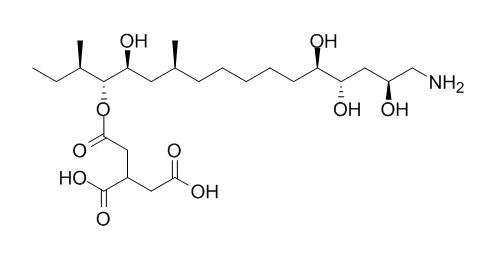AAL Toxin TA2
AAL toxins TA and TB are phytotoxins, isolated from corn cultures by aqueous extraction. AAL-toxin has a wide range of phytotoxicity, it has potential as a natural herbicide because several important weeds including jimsonweed, black nightshade, prickly sida and hemp sesbania are quite sensitive, while some crops such as cotton and maize are not affected.
Inquire / Order:
manager@chemfaces.com
Technical Inquiries:
service@chemfaces.com
Tel:
+86-27-84237783
Fax:
+86-27-84254680
Address:
1 Building, No. 83, CheCheng Rd., Wuhan Economic and Technological Development Zone, Wuhan, Hubei 430056, PRC
Providing storage is as stated on the product vial and the vial is kept tightly sealed, the product can be stored for up to
24 months(2-8C).
Wherever possible, you should prepare and use solutions on the same day. However, if you need to make up stock solutions in advance, we recommend that you store the solution as aliquots in tightly sealed vials at -20C. Generally, these will be useable for up to two weeks. Before use, and prior to opening the vial we recommend that you allow your product to equilibrate to room temperature for at least 1 hour.
Need more advice on solubility, usage and handling? Please email to: service@chemfaces.com
The packaging of the product may have turned upside down during transportation, resulting in the natural compounds adhering to the neck or cap of the vial. take the vial out of its packaging and gently shake to let the compounds fall to the bottom of the vial. for liquid products, centrifuge at 200-500 RPM to gather the liquid at the bottom of the vial. try to avoid loss or contamination during handling.
Phytomedicine.2018, 40:37-47
Hum Exp Toxicol.2022, 41:9603271221143713.
Daru.2024, 32(2):689-703.
Biochem Biophys Res Commun.2018, 505(4):1148-1153
J Int Med Res.2021, 49(7):3000605211032849.
Int J Mol Sci.2022, 23(11):6104.
Biomolecules.2020, 10(6):925.
Carbohydrate Polymer Technologies & App.2021, 2:100049.
Korean Herb. Med. Inf.2020, 8(2):243-254.
Current Analytical Chemistry2024, 20(8):599-610.
Related and Featured Products
Pestic. Sci.,1995, 43, 181-187
AAL-toxin, a potent natural herbicide which disrupts sphingolipid metabolism of plants[Reference:
WebLink]
METHODS AND RESULTS:
AAL-toxin, a natural product, has a wide range of phytotoxicity. It has potential as a natural herbicide because several important weeds including jimsonweed, black nightshade, prickly sida and hemp sesbania are quite sensitive, while some crops such as cotton and maize are not affected. This differential susceptibility may allow its exploitation for weed control.
CONCLUSIONS:
The data obtained to date a r e consistent with the hypothesis that the toxin disrupts sphingolipid metabolism and it is hoped that future studies will confirm these preliminary findings. More research is needed in the field to determine feasibility of commercial development of the toxin and its analogues as natural herbicides. Attention to human and mammalian toxicity will also be required.
Journal of Chromatography A,1993,641(1):95-100
Isolation and determination of AAL phytotoxins from corn cultures of the fungus Alternaria alternata f. sp. lycopersici[Reference:
WebLink]
METHODS AND RESULTS:
The fungus Alternaria alternata f. sp. lycopersici produces a group of four related host-specific phytotoxins (AAL toxins) which can be divided into two groups (TA and TB), each of which exists as an equilibrium mixture of two structural isomers. The AAL toxins were isolated from corn cultures by aqueous extraction, followed by purification on Amberlite XAD-2 resin, separation of TA from TB on silica gel and final purification on a semi-preparative high-performance liquid chromatographic (HPLC) system. A rapid, sensitive and reproducible method was developed to determine these toxins in culture material in order to monitor toxin production on corn cultures. The method consisted of aqueous extraction, C18 solid-phase extraction clean-up, precolumn derivatization with o-phthaldialdehyde and reversed-phase HPLC with fluorescence detection.
CONCLUSIONS:
An isocratic HPLC system was developed that separated the structural isomers of TA and TB within a chromatographic analysis time of 24 min.



